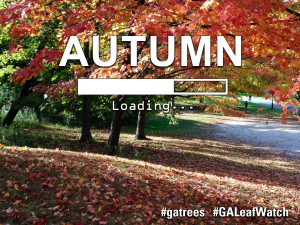 While 2020 has thrown us some curves, one constant we can depend on is a colorful autumn in north Georgia. Dropping temperatures and sunny days usher in a special time of gratitude, with an enhanced appreciation for Mother Nature and human connection – and who’s not feeling those emotions right now? The fall foliage season is upon us and the science behind leaf color change is remarkable.
While 2020 has thrown us some curves, one constant we can depend on is a colorful autumn in north Georgia. Dropping temperatures and sunny days usher in a special time of gratitude, with an enhanced appreciation for Mother Nature and human connection – and who’s not feeling those emotions right now? The fall foliage season is upon us and the science behind leaf color change is remarkable.
Autumn leaf color change, or “leaf senescence,” begins after the fall equinox, better known as the “first day of fall.” The shortening days and decreased sunlight hours provide a signal to the trees (as well as many other species of plants, animals, and insects) that it’s time to start preparing for dormancy until next spring. As sunlight hours decrease, leaves stop replacing their chlorophyll, the pigment which give leaves the green color we all know. Yellow and red pigments move in to take their place. These changing pigments provide a sunscreen to protect plant cells from seasonal changes in UV radiation wavelength, allowing the cells to do their job and get as many of the nutrients, sugars, and resources moved from the leaf back into the stem. The tree can then seal off its woody tissue to conserve those resources for reallocation next spring. So fall leaf color change is not only a visual feast for our eyes, it is an essential part of the annual life cycle of deciduous trees. A fully expressed leaf senescence makes for better sugar production during the growing season, and a vigorous tree with good sugar production will typically have better expressed fall color.
If you want to bring some fall color to your backyard or community, there are many native trees you can plant. Red maples provide some of the most brilliant fall color, but many of the oaks, such as scarlet or shumard, can also have great color. Blackgum expresses some very vivid color, and bald cypress provides unique texture as well as attractive color to a landscape. The best bet to get the fall color you want in your yard is to go outside and look at different tree species during their leaf color expression. You’ll discover the shades or red, yellow, orange and more that speak to your eyes and your soul. Check out GFC’s Fall Leaf Watch resources at gatrees.org (#GALeafWatch) for first hand reports from our foresters, chronicling where the most vivid fall leaf color viewing is occurring throughout the state, week to week.
As you pause to appreciate the many colors of fall this year, remember that the trees have been changing color since before we started “leaf color watches.” It is an essential life process for trees, and just another item on the long list of services trees provide every day. If we care for our trees all year ‘round, then we can more fully enjoy the color show in the fall!
